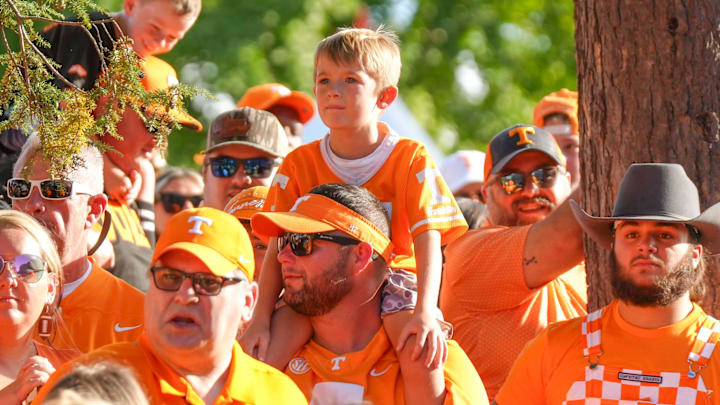Tennessee’s 10% NIL Ticket Surcharge is Insulting to Volunteer Fans

University of Tennessee Athletic Director Danny White recently announced that the university is implementing a new 10% surcharge on ticket prices for the upcoming 2025-2026 season. The strategic move comes in response to potential NIL revenue sharing for college athletes that could arrive as early as next season and cost the most prominent schools roughly $22,000,000 annually –– White has aptly monikered the new cost a “talent fee.” The “talent fee” implicates both single-game and season ticket sales and will complement the projected average 4.5% increase in ticket sales at Neyland Stadium in the coming year.
This is enough for Volunteer fans to revolt. In an interview with On3 White stated “It’s going to our student athletes as part of this new world order in college sports. So I know our fans will embrace it.” I’d think twice about the embrace of a price hike on fans who have seen nothing but constantly increasing ticket costs. After begging fans to donate hard-earned money to their NIL collective for the last three years, the Volunteer Athletic Department also wants those same fans to subsidize their athlete payment costs. How far can Volunteer administration expect fans to stretch their wallets?
Power 5 colleges have gotten away with not paying their on-field talent while often raking in over nine figures annually from media rights partnerships, donations, ticket sales, and licensing fees. In the 2022-23 academic year, the Volunteers athletic department generated $202,097,305 in revenue –– this was before the 2024 SEC media deal that now entitles Tennessee and every other SEC program to an extra $15,000,000 in media rights payments every year. You can see the full financial breakdown of every public university here.
The NCAA system that restricts direct athlete payment has allowed schools in big-time conferences to rake in money without ever having to pay their talent –– in the professional sports landscape players and owners hover around a 50-50 split in revenue. The proposed NCAA direct NIL payout of $22,000,000 is closer to a 90-10 split in favor of ownership when looking at Tennessee’s 2022-23 revenues.
For so long, college athlete labor exploitation has allowed power conference athletic departments to have tremendous bloat — unnecessary expenditures in personnel, facilities, and inflated coaching and administrative salaries are pervasive around campuses. Most power conference schools are public, meaning they have a “use it or lose it” mentality. There are no shareholders at public institutions like Tennessee; if the Vols were to experience a year with an incredible profit margin, no institutional shareholder would be directly richer for it.
In practice, that means that every dollar the athletic department earns should be spent. In 2023, Tennessee spent over $191,000,000 in athletic expenditures. The restriction of athlete payment and lack of profit incentives have made college sports economics wonky. It is the reason why twelve offensive coordinators in the college ranks are making over $1,000,000 in 2024. It is also why so many power conference football locker rooms have price tags above $100,000,000 – below is a rendering of the recent $30,000,000 upgrade to Tennessee’s locker room.
Prioritizing the student-athlete experience.
— Tennessee Football (@Vol_Football) November 11, 2021
Unveiling the approved plans for a $30 million upgrade and expansion of the current 145,000-square-foot Anderson Training Center — the home of Tennessee Football.
Yes, non-revenue athletic programs hemorrhage money. The rational reader would point out that if you want to fix the budget, the best move is to cut these programs, which have become increasingly costly in an era of non-geographical conference realignment. That would be a fair argument, but in a purely revenue-driven collegiate sports landscape, why have such a large revenue split discrepancy from the industry standard?
The 90-10 revenue split in favor of ownership accounts for the subsidies necessary for non-revenue and Olympic sports programs to be supported through football and basketball. In a system that is truly profit motivated a 50-50 revenue split seen from every large American sporting league would be expected. A school like Tennessee would be on the hook for $100,000,000 and not $22,000,000 annually for athlete payment — meaning a lot more belt-tightening and a lot more loss of opportunity.
Danny White made $2,310,000 in 2023, and the entire athletic administration, excluding coaches, made a total of $36,040,365. Tennessee coaching salaries in 2023 totaled $34,916,833: Josh Heupel made $9,000,000; Rick Barnes made $5,700,000; Women’s basketball coach Kellie Harper made $1,100,000; and Defensive Coordinator Tim Banks made $1,500,000. White is asking hard-working Tennessee fans to pay 14.5% more in ticket prices so his salary can continue to climb and he can maintain a bloated athletic department.
The $15,000,000 increase in media rights payment is shockingly left out of SEC stakeholders’ messaging when discussing the “rapidly evolving landscape of college sports.” Schools in the Big Ten earn roughly $40,000,000 more annually from their new giant media rights contract, yet continue to message that they NEED more money to survive in the new landscape –– where did those dollars go?
The NCAA has opened opportunities for schools to generate new revenue streams to prepare for the additional costs of athlete payment. Many schools have quickly cashed in on the NCAA's removal of prior restrictions against on-field sponsorships. Tennessee has inked a new multi-year deal with Pilot, including on-field sponsorship, which is expected to bring substantial funding.
There are plenty of ways athletic departments can cut costs and generate revenue to offset potential athlete NIL revenue share payments. Passing the buck to those wanting to attend games is a selfish and tone-deaf move to preserve the opulent spending within Tennessee’s athletic department.
